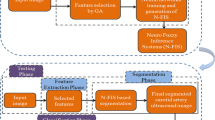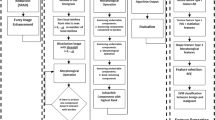Abstract
This paper presents a method for accurate location of the vessel borders based on boosting of classifiers and feature selection. Intravascular Ultrasound Images (IVUS) are an excellent tool for direct visualization of vascular pathologies and evaluation of the lumen and plaque in coronary arteries. Nowadays, the most common methods to separate the tissue from the lumen are based on gray levels providing non-satisfactory segmentations. In this paper, we propose and analyze a new approach to separate tissue from lumen based on an ensemble method for classification and feature selection. We perform a supervised learning of local texture patterns of the plaque and lumen regions and build a large feature space using different texture extractors. A classifier is constructed by selecting a small number of important features using AdaBoost. Feature selection is achieved by a modification of the AdaBoost. A snake is set to deform to achieve continuity on the classified image. Different tests on medical images show the advantages.
Access this chapter
Tax calculation will be finalised at checkout
Purchases are for personal use only
Preview
Unable to display preview. Download preview PDF.
Similar content being viewed by others
References
R.E. Schapire: “The Boosting Approach to Machine Learning. An Overview”. MSRI Workshop on Nonlinear Estimation and Classification. 2002.
P. Viola and M. Jones: “Rapid Object Detection using a Boosted Cascade of Simple Features”. Accepted Conference on Computer Vision and Pattern Recognition 2001.
G. Ratsch, T. Onoda, and K.-R. Muller: “Soft Margins for AdaBoost”. NeuroColt2 Technical Report Series. NC-TR-1998-021.
J. Malik, S. Belongie, T. Leung, and J. Shi: “Contour and Texture Analysis for Image Segmentation”. International Journal of Computer Vision. 43(1), 7–27,2001.
J. Puzicha, T. Hoffman, and J. Buhmann: “Unsupervised texture segmentation in a deterministic anhealing framework”. Trans. on Pattern Recognition and Machine Intelligence. 20(8): 803–818,1998.
M. Sonka, X. Zhang, M. Siebes et al.: “Segmentation of intravascular ultrasound images: A knowledge based approach”. IEEE Trans. on Medical Imaging. 14: 719–732. 1995.
X. Zhang, C.R. McKay, and M. Sonka: “Tissue Characterization in intravascular ultrasound images”. IEEE Trans. on Medical Imaging. 17: 889–899. 1998.
C. von Birgelen, A. van der Lugt, A. Nicosia et al.: “Computerized assessment of coronary lumen and atherosclerotic plaque dimensions in three-dimensional intravascular ultrasound correlated with histomorphometry”. Amer. J. Cardiol. 78: 1202–1209, 1996.
J.D. Klingensmith, R. Shekhar, and D.G. Vince: “Evaluation of Three-Dimensional Segmentation Algorithms for Identification of Luminal and Medial-Adventitial Borders in Intravascular Ultrasound Images”, IEEE Trans. on Medical Imaging, 19(10): 996–1011, 2000.
R. Haralick, K. Shanmugam, and I. Dinstein: “Textural Features for Image Classification”. IEEE Trans. System, Man, Cybernetics. 3: 610–621. 1973.
P.P. Ohanian and R.C. Dubes: “Performance Evaluation for Four Classes of Textural Features”. Pattern Recognition. 25(8), 819–833, 1992.
Trygve Randen and John H. Husoy: “Filtering for Texture Classification: A Comparative Study”. Pattern Recognition. 21(4): 291–310. 1999.
M. Turceyan: “Moment Based texture segmentation”. Pattern Recognition Letters. 15: 659–668. 1994.
J. Martinez and F. Thomas: “Efficient computation of local geometrical moments”. Submitted to IEEE Trans. on Image Processing.
Richard O. Duda, Peter E. Hart, and David G. Stork: “Pattern Classification”. Wiley-Interscience, 2001. 2nd Ed.
M. Kass, A. Witkin, and D. Terzopoulos: “Snakes, Active contour models”. Int. J. Computer Vision, 1(4): 321–331. 1987.
V. Caselles, F. Catte, T. Coll, and F. Dibos: “A geometric model for active contours”. Numerische Mathematik. 66: 1–31, 1993.
T. McInerney and D. Terzopoulos: “Deformable models in medical images analysis: a survey”. Medical Image Analysis. 1(2): 91–108, 1996.
Author information
Authors and Affiliations
Editor information
Editors and Affiliations
Rights and permissions
Copyright information
© 2003 Springer-Verlag Berlin Heidelberg
About this paper
Cite this paper
Pujol, O., Rosales, M., Radeva, P., Nofrerias-Fernández, E. (2003). Intravascular Ultrasound Images Vessel Characterization Using AdaBoost. In: Magnin, I.E., Montagnat, J., Clarysse, P., Nenonen, J., Katila, T. (eds) Functional Imaging and Modeling of the Heart. FIMH 2003. Lecture Notes in Computer Science, vol 2674. Springer, Berlin, Heidelberg. https://doi.org/10.1007/3-540-44883-7_25
Download citation
DOI: https://doi.org/10.1007/3-540-44883-7_25
Published:
Publisher Name: Springer, Berlin, Heidelberg
Print ISBN: 978-3-540-40262-6
Online ISBN: 978-3-540-44883-9
eBook Packages: Springer Book Archive




